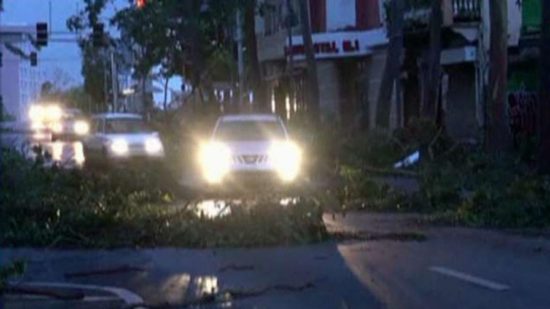ROSEAU, Dominica — Hurricane Maria smashed into the island of Dominica with 160 mph winds, ripping the roof off even the prime minister’s residence and causing what he called “mind-boggling” devastation Tuesday Sept. 19 as it plunged into a Caribbean region already ravaged by Hurricane Irma.
Forecasters predict Maria will continue moving in a direction that poses no threat to the Yucatan Peninsula.
The Associated Press reported the storm was on a track to wallop Puerto Rico on Wednesday “with a force and violence that we haven’t seen for several generations,” the territory’s governor said.
Dominica Prime Minister Roosevelt Skerrit said on his Facebook page that “initial reports are of widespread devastation” and said he feared there would be deaths due to rain-fed landslides.
“So far the winds have swept away the roofs of almost every person I have spoken to or otherwise made contact with,” Skerrit wrote. “The roof to my own official residence was among the first to go.”
And he appealed for international aid:
“We will need help, my friend, we will need help of all kinds.”
Maria’s eye roared over the island late Monday night. The storm briefly dipped to Category 4 strength early Tuesday before regaining Category 5 status (the highest rated in terms of wind speeds):
Fierce winds and rain lashed mountainous Dominica for hours. A police official on the island, Inspector Pellam Jno Baptiste, said late Monday night that there were no immediate reports of casualties but it was too dangerous for officers to check conditions.
“Where we are, we can’t move,” he said in a brief phone interview while hunkered down against the region’s second Category 5 hurricane this month.
“The winds are merciless! We shall survive by the grace of God,” Skerrit wrote at the start of a series of increasingly harrowing posts on Facebook.
A few minutes later, he messaged he could hear the sound of galvanized steel roofs tearing off houses on the small rugged island.
He then wrote that he thought his home had been damaged, and added: “Rough! Rough! Rough!”
On the nearby island of Martinique, officials said about 25,000 households were without electricity and two small towns without water after Maria roared past.
The head of French civil security, Jacques Witkowski, told reporters that it was too soon to say whether the French department of Guadaloupe had fared as well.
Prefect Eric Maire, the highest French official of Guadaloupe, said in a video on Twitter that some roads and homes were flooded and heavy rain expected to continue. He told the population to “remain inside.”
“You have to evacuate. Otherwise, you’re going to die,” said Hector Pesquera, the island’s public safety commissioner. “I don’t know how to make this any clearer.”
Maria had maximum sustained winds of 160 mph (260 kph) late Monday when it slammed into Dominica.
The U.S. National Hurricane Center said Maria weakened briefly before recovering sustained winds of 160 mph (260 kph) strength shortly before daybreak Tuesday. Its eye was located about 170 miles (275 kilometers) southeast of St. Croix, and the storm was moving west-northwest over the Caribbean at 9 mph (15 kph).
Forecasters warned Maria could even intensify over the next 24 hours or longer, noting its eye had shrunk to a compact 10 miles across and warning: “Maria is developing the dreaded pinhole eye.”
That generally means an extremely strong hurricane will get even mightier, said Brian McNoldy, a hurricane researcher at the University of Miami. He said it just like when a spinning ice skater brings in their arms and rotates faster.
“You just don’t see those in weaker hurricanes,” he said.
The storm’s hurricane-force winds extended out about 35 miles (45 kilometers) and tropical storm-force winds out as far as 125 miles (205 kilometers).
Hurricane warnings were posted for the U.S. and British Virgin Islands, Puerto Rico, Guadeloupe, Dominica, St. Kitts, Nevis and Montserrat. A tropical storm warning was issued for Martinique, Antigua and Barbuda, Saba, St. Eustatius, St. Maarten and Anguilla.
In Puerto Rico, nearly 70,000 people were still without power following their earlier brush with Irma and nearly 200 remained in shelters as Maria approached.
Gov. Ricardo Rossello said Puerto Rico had 500 shelters capable of taking in up to 133,000 people in a worst-case scenario. He also said the Federal Emergency Management Agency was ready to bring drinking water and help restore power immediately after the storm, which could hit as a Category 5 hurricane.
“This is going to impact all of Puerto Rico with a force and violence that we haven’t seen for several generations,” he said. “We’re going to lose a lot of infrastructure in Puerto Rico. We’re going to have to rebuild.”
To read complete article click here.
Source: apnews.com


